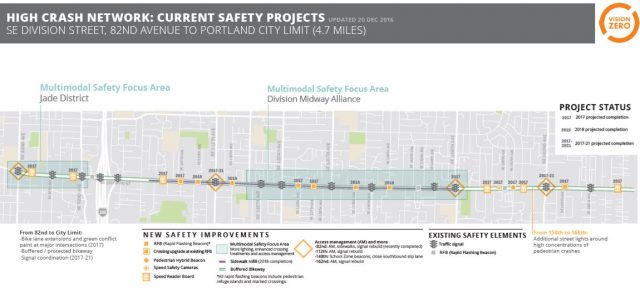
Emotions around street safety issues ran high at the end of 2016. Not only did we have the most road fatalities (45) since 2003, but we lost six Portlanders to traffic violence in the final month alone.
When two of those six happened within just a few hours of each other and on the same, notoriously dangerous section of Southeast Division Street where three other people died last year, the pressure to do something intensified. (Now former) Mayor Charlie Hales and his four commissioners took steps to address the situation at a meeting on December 21st.
“We have a lot of streets in our city that were not designed for pedestrian and bicycle safety and were designed for automotive speed. And that’s deadly and we keep learning that lesson. This [ordinance] allows us to do a little more a little more quickly.”
— Charlie Hales, Mayor of Portland (at the time he said it on December 21st)
We dropped the thread of this story due to the holidays but it deserves to be picked back up. Before we recap what happened at the council meeting, here’s a quick refresher…
Two days after the tragedies on December 7th, bereaved family members penned a letter to City Council calling for immediate action. Almost immediately the volunteer street reform activists from BikeLoud PDX swung into action and scheduled a “Public Takeover” of the street that was more successful than anyone had expected.
And the City of Portland wasn’t far behind. Just nine days after the two fatalities they announced an ordinance that would give the transportation bureau permission to use $300,000 from the City’s contingency fund for traffic safety outreach and education efforts in the adjacent neighborhoods.
We’ve learned by watching the video of the City Council meeting on the 21st that Hales and PBOT actually swung into action much quicker than that. PBOT Active Transportation and Safety Division Manager Margi Bradway apparently picked up the phone the morning after the deaths and talked to leaders from the Division-Midway Alliance neighborhood association. Also on that day Mayor Hales set up a conference call with Bradway, her boss PBOT Director Leah Treat, PBOT Commissioner Steve Novick, members of the Portland Police Bureau, and others.
In his introduction of the Outer Division safety ordinance, Hales addressed commissioners, activists, and PBOT staff in Council chambers by saying, “Having had two of our neighbors killed in one day on one street is a terrible reminder of how much we have to do to achieve Vision Zero.” “We have a lot of streets in our city that were not designed for pedestrian and bicycle safety and were designed for automotive speed,” Hales continued, “And that’s deadly and we keep learning that lesson. This [ordinance] allows us to do a little more a little more quickly.”
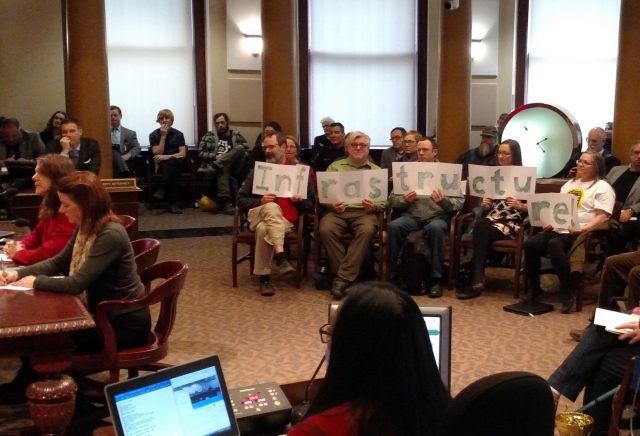
(Photo: BikeLoudPDX)
When word of the ordinance leaked out last month many activists were intially disappointed that it would pay only for education and outreach. They want one thing: more physical infrastructure to reduce driving speeds and overall auto volume. In fact, several volunteers with BikeLoud PDX and Families for Safe Streets sat in the front row at the meeting holding a sign that read, “I-N-F-R-A-S-T-R-U-C-T-U-R-E,” just to get their point across.
What they didn’t yet know was that Bradway had good news to share.
Bradway, a former environmental lawyer and high-level staffer at the Oregon Department of Transportation, told Mayor Hales and Council during a short presentation that PBOT has more in store for outer Division than just an educational campaign. (Although it’s important to note that the education and outreach campaign is a priority that came from community members — many of whom represent people who don’t speak English. Both of the people who were hit and killed while walking on December 7th were Chinese elders not born in the United States.)
The agency says in light of recent deaths they will speed up their timetable for placing speed radar cameras on Division at 156th. Initially slated for installation this coming July, they will try and have them in by the end of this month. PBOT plans to meet with County traffic court and Police Bureau reps on January 5th to see how long it will be until citations can be issued. When these cameras were installed on Beaverton-Hillsdale Highway last fall the City says they reduced speeding by a whopping 93 percent.
Advertisement
“That’s what Vision Zero is. It’s admitting we’re making this tradeoff: We’re either going to accept that mortality is the cost of mobility or we’re not. And if we’re not, then we need less mobility.”
— Alan Kessler, citizen activist
In addition to the cameras PBOT will install speed reader boards. Both those measures are intended to reduce speeds and lay groundwork for PBOT to make a formal request to ODOT to reduce the speed limit to 30 mph (from 35 mph). Bradway said PBOT data shows the 85th percentile speed on this stretch of Division is currently 42 mph and ODOT would scoff at any request for a 30 mph limit unless those speeds first came down.
Bradway then pointed out that PBOT already has about $7 million worth of projects lined up for outer Division and the agency is trying to “accelerate” them. Those projects are mostly related to new crosswalks and flashing beacons — three of which are slated to be built this summer.
The new 10-cent per gallon gas tax that the city started collecting on January 1st will also help on Division. In what was sort of a sleeper announcement, Bradway said a $168,000 bike lane project on Division will be bolstered by another $500,000 for “a complete traffic calming project” on the street that will include “pedestrian refuge islands, lighting, and other ways to slow the speeds down.” To accomplish this, Bradway said PBOT is considering removing parking and potentially limiting auto access on a section between SE 114th and 148th (See lead graphic).
After Bradway’s testimony council heard from Rosaline Hui, editor of the Chinese Times. She shared how the wife of Rohgzhao Zhang, the 65-year-old man killed on December 7th while walking across Division, learned of his death. She walked to the scene after he didn’t come home and saw all the police. But she couldn’t speak to them because she doesn’t use English. “They had just been here for a year’s time,” Hui said, “To look for a better life and find opportunity for their son and grandkids to have a better life. Because of the death of Mr. Zhang, it has all vanished.”
Hui said many people in the Jade District are immigrants who don’t drive and who walk everywhere. “When we walk in the street it’s like we are walking into a tiger’s mouth, you are putting your life in danger,” she said. Hui advocated for road signs in both Chinese and Vietnamese. She also said the road is too wide and too many people are speeding.
Everyone who testified offered strong support for major changes to Division that would reconfigure lanes and make biking and walking safer.
Even Jessica Engelman, the woman who organized the “Public Takeover” event a few weeks earlier said in testimony that, “I am impressed at who showed up today and they said a lot of what I wanted to say.”
Noel Mickelberry with Oregon Walks applauded PBOT and said, “This is the most comprehensive response I have seen.”
Other activists testified in what became sort of a lesson in Vision Zero for all the commissioners. Alan Kessler said he’s frustrated that PBOT’s main response is usually just crosswalks and flashing lights. He wants more them to be more bold. “It’s frustrating to watch money drip, drip, drip away on a beacon here and a crosswalk there when we know what we need to do is reduce throughput. And that’s politically really difficult; but that’s what Vision Zero is. It’s admitting we’re making this tradeoff: We’re either going to accept that mortality is the cost of mobility or we’re not. And if we’re not, then we need less mobility.”
The ordinance passed unanimously.
Commissioner Novick said it shows, “Council is willing to do as much as we can as quickly as we can to end the carnage on outer Division.”
And Commissioner Dan Saltzman, the newly appointed PBOT leader under Mayor Ted Wheeler, shared a strong statement. “We are clearly failing at pedestrian safety and we need to do a better job. Vision Zero is great but it’s against the backdrop of record fatalities, so something clearly is not right. We need to fix it. The will in this room is here. The will on this council, and I expect on future councils, is here. We will find ways to make our environments safer for everybody who uses our roads.”
— Jonathan Maus, (503) 706-8804 – jonathan@bikeportland.org
BikePortland is supported by the community (that means you!). Please become a subscriber or make a donation today.



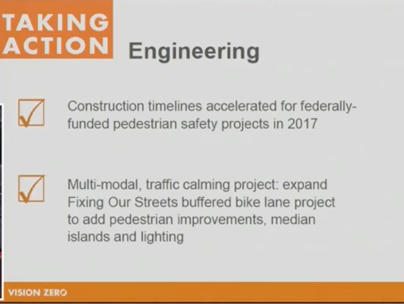
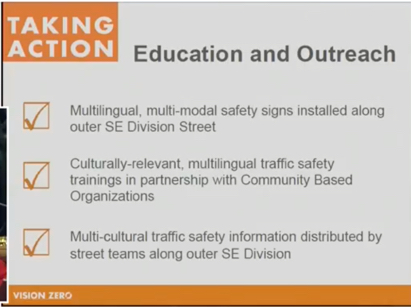
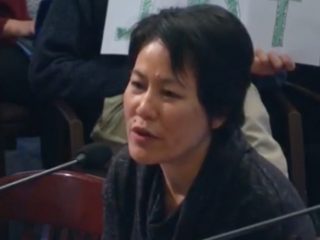


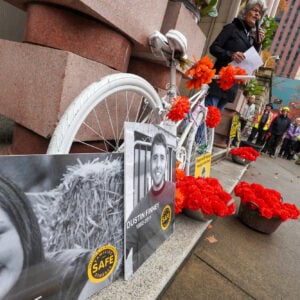
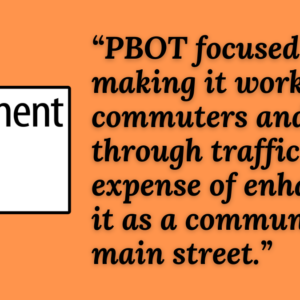
Thanks for reading.
BikePortland has served this community with independent community journalism since 2005. We rely on subscriptions from readers like you to survive. Your financial support is vital in keeping this valuable resource alive and well.
Please subscribe today to strengthen and expand our work.
Glad to hear this!
I love the safety cameras on BH Highway by Fanno Creek! It is not a placebo effect. The air is cleaner and my brain can process everyday sights more easily.
The on-street car parking needs to be removed.
What would parking removal accomplish? It will make it appear to motorists to be a freeway where 70 mph is allowed. Is that what you want?
put the buffered bike lane where cars now park and make the outside travel lane a pro-time parking lane. Two lanes in during the AM peak and two lanes outbound during the PM peak. one lane each way the other 20+ hours of the day.
How will this work in practice when those parking lanes are hardly used? Outer Division is not exactly the inner city where parking utilization and turnover are high. Additionally, does PBOT have the resources to tow cars that are illegally parked during peak-hour times?
curb extensions and scattered parked cars?
scratch the curb extension.
Plant more trees.
So is it looks like most of Division will be a buffered bikeway according to the map? If so I still won’t ride it, ever. “Hey slow down everybody there is a buffered bikeway here” not a plan. Crosswalks are great but unless it loses a lane it won’t get slower or safer.
What if it became 30 mph? 25 mph with lots of police enforcement? More streets trees? Moratorium to halt new drive-thru business?
When ODOT presented their concepts for “safety improvements” along Powell Boulevard near Cleveland High School, they were actually proposing REMOVING street trees to improve visibility!!! Duh?
#ODOT #WarOnTrees
No way in hell I’d ever ride on a slightly wider bike lane on outer Division without full curb separation.
Aren’t there quieter side streets you can take as an alternative?
fortunately, i believe the bike lane preferences of individuals carry far less weight at PBOT than actual safety data.
for exampl: striping of buffered bike lanes on a 4 lane highway in east portland resulted in:
– and ~84% reduction in injury collisions
– 1,855 total reduction in cars per day 38-44 mph
– 548 total reduction in cars per day 44-49 mph
– 88 total reduction in cars per day 50+ mph
http://bikeportland.org/wp-content/uploads/2011/05/Holgate_Open_House_Presentation.pdf
apologies for typos.
Yeah – but Hiolgate’s buffered bike lane was accompanied by a motor vehicle lane reduction, which reduces speeding both through direct means (I, the speeder, am quickly ‘stuck’ behind someone going the speed limit) and indirect means (less of a highway feel –> less of an urge to speed). Is that the City’s proposal on Division? As I recall, the City is proposing to keep two motor vehicle lanes each way. I’m not convinced that turning motor vehicle parking lanes into buffered bike lanes will have much, if any, impact on speeding. They will make it much more comfortable to bike (though they will get not it all the way to the state of “comfortable” for me).
This *NEW* proposal suggests the possibility of motorvehicle lane reduction to me:
https://www.portlandoregon.gov/transportation/article/621643
there’s no room for a buffered bike lane without removing a lane, so I assume they’re going to remove a lane…
like you say, it’s useless to do all this and keep the extra lane… we already have all these treatments at the exact place people are dying… if we don’t take away a motor vehicle lane in each direction and lower the speed limit then we’ve failed…
It seems like removing on-street parking could encourage faster driving. Does anyone know the rationale for removing it? Does it free up space for bike lane buffers?
8 foot parking lane = 6 foot bike lane and 2 foot buffer. Make the current outside travel lane into a pro-time parking lane.
thanks, that makes sense.
Any consideration to remove the center lane pavement? How much would it cost to create a de facto median (eg vegitated) and have the center turning lane only when necessary at major intersections?
I thought PBOT wasn’t doing pro-time parking anymore?
I would trade faster traffic for being able to see that traffic before setting foot into an intersection.
That said, there’s no mandate that says that removing parking has to result in a wider/faster road. I would gladly turn every on-street parking space into green space if my magic wand was working. A significant portion of the “parking as traffic calming” advocates are nothing more than parking advocates.
Then again, I’m not a traffic planner or politician focused on death statistics. My preference is not to get hit in the first place.
On-street parking isn’t used very much on outer Division except at 87th and around 122nd. I’d get rid of the parking lane on one side along the whole length, say the south side, and re-align all the lanes accordingly.
Any design for outer Division that maintains the existing four travel lanes is a non-starter. Division first and foremost needs to lose two of those lanes. No amount of rapid-flash beacons, refuge islands, painted crosswalks, or buffered bike lanes will fix Division. The root of all Division’s problems is it’s car-centric design, and all the “solutions” proposed here are still car focused because all they do is tell people where to go so that drivers might notice them easier. Nothing here actually puts people first – it still allows drivers to mostly carry on, business as usual. Division needs a complete lane reallocation to remove two of the motor vehicle travel lanes and use the reclaimed roadway space to build wider sidewalks and curb-protected bike lanes. If we are going to fix Division, we need to go all-in. No band-aid solutions will be good enough.
Eliminating lanes will simply force more traffic onto the nearby 4M bikeway – SE Market, Mill, Millmain, & Main Streets, as well as onto Stark. Given that most drivers are now dependent upon their GPS devices for finding low-traffic streets to speed on plus the endemic lack of speed enforcement in Portland, you’ll be just pushing more car traffic into the neighborhoods, leading to even more deaths. A total non-starter.
Then add diversion to parallel streets as part of this project. This is what should have been done to Clinton Street during the inner-Division rebuild.
“Then add diversion to parallel streets as part of this project. …” adam h
As part of reducing motor vehicle speeds on this road, diverting thoroughfare traffic to parallel side streets may not be necessary if all of Division’s four lanes are retained. Division has the lane volume it probably does need to adequately accommodate traffic of all modes, now and going into the future with a larger population.
Bring the top posted, and average mph motor vehicle speed down through: great idea to explore. Eliminating two of the roads’ main lanes of travel: not a good choice as a first option…maybe ok as a last resort.
To reduce speeds we could try E N F O R C E M E N T.
Stop sign enforcement in Ladd’s Addition causes cyclists to slow down for a week or so. Maybe saturation patrols on Division would cause motorists to slow down for a week or two. Worth a try?
enforcement is incredibly expensive, unjust, and of questionable effectiveness.
vision zero road re-design (including speed cameras) is less expensive, more equitable, and supported by evidence.
Conformity to the law is not unjust. You’re not a victim if you break the law.
Speed cameras are a form of enforcement. Self-sustaining, incredibly effective, non-discriminating enforcement.
i agree. and this is why i support stronger vision zero reforms instead of giving more money to the half trillion dollar fiscal black hole that is portland’s public safety budget
Just how much do you think redesigning and rebuilding a mile of arterial streets does cost?
Don’t forget to factor in removal and replacement of traffic signals in their new locations; moving curbs; upgrading sidewalks and ramps for ADA compliance; changing and upgrading stormwater systems including adjusting the inlets when you move curbs; landscaping and its’ maintenance.
I’m not saying I don’t support redesign, but I think you drastically underestimate the cost if you think it’s less expensive than enforcement.
We don’t enforce the speed limit for 11mph over, so that’s not very effective, yeah.
The term “Deadly Division” sums it up!
Did I read this right? ODOT won’t lower the speed limit until speeds come down? Ummm, isn’t the point on a lower speed limit (assuming enforcement) is to lead to lower speeds. Are we living in Opposite Land?
Yes.
Thats the beauty and stark perversity of the “85th percentile speed” ‘rule’…a commonly used traffic engineering standard that was best used for rural or very autocentric/suburban 1960s environments…but sadly carried over into widespread use for cities.
“… the “85th percentile speed” ‘rule’…” boulanger
That arbitrary formula for establishing posted speed limits is the first major obstacle that should be tackled as part of efforts to have streets like Division and others as well, become better and safer for all road users.
How can 85 percent of whatever mph a majority or people driving on the road want to travel, be relied upon to provide motor vehicle speeds that are compatible, safe and comfortable to use by people of other modes of travel, and that don’t unduly detract from livability of the neighborhood the road passes through?
The city and ODOT ought to consider, at least for a trial basis, experimenting to see just how low a speed limit could be applied to this section of outer Division, and still allow the street to facilitate reasonable, efficient traffic flow during peak traffic hours of the day.
Painted or decal speed limit signs, plus the labor to install them, doesn’t cost a lot of money compared to other traffic calming measure, although some of them, such as speed limit cameras, reader boards and speed radar vans, ought to be brought in too, as planned. Try those things first before making the more major, expensive, and contorversial change that a road reduction would represent.
It does cost a lot of money to deal with (mitigate) the negative impacts of slow speeds on Division. Traffic will simply re-route itself onto neighborhood streets, where enforcement is equally lax, and drivers will use their GPS devices to find those streets. To prevent this, speed bumps need to be installed on all local streets, which PBOT will not do and which the Fire Bureau will veto.
There are very few viable east-west alternatives close to Division. Slower speeds without lane reductions will do very little to reduce Division’s throughput, so why would people divert?
Because people are rarely rational. They like to keep moving, faster if possible, even if they are taking longer or going further. But you are right, it isn’t logical, and it is certainly energy-wasting and time-wasting to use side streets in East Portland, when they exist.
It’s only inefficient and slower if you obey the speed limit, stop at stop signs, and yield to pedestrians.
As long as people driving feel they can expect traffic on Division to flow fairly smoothly, it seems to me they may not object too much to the posted speed limit being set at say, 25mph (I’m not exactly sure what speed Division is posted for now…35 perhaps?). 20mph would be an adjustment for sure, but it could be worth trying.
I think most people using thoroughfares will stay on the street as long as traffic keeps moving, and won’t turn off for a cut-through on a neighborhood street, unless traffic really stagnates to stop and go traffic, or say, 5mph to 10mph. So to me, minimize cut-through, it seems very important to set the road up so traffic can flow safely and as smoothly as reasonably possible. Most people aren’t going to bother cutting through neighborhood streets if it’s easier to just cruise along at 20mph or so on the thoroughfare.
After evening commute, evening and into the early hours of the morning is where I’d suspect that excessive speeding is particularly tempting to to some of the people driving. Fewer motor vehicles on the road, oftentimes maybe not many at all, less traffic in general.
Some people like to drive excessively fast on the street for no particular reason than they like to drive fast, or they’re nervous, feel like they’ve got to meet some arbitrary schedule, or whatever. That as far as I’m concerned, is bad driver conduct and disposition, even outside of resulting close calls and collisions.
Better road and traffic management through even such relatively simple things as signage and speed monitoring and speed display equipment, may be able to help some of the people that drive while they’re in a poor state of mind or with less restraint on themselves than they should be using…to get better control over themselves and their manner of driving, to be safer road uses.
Yes. Let’s suppose the average federal taxes for a community are $5000 per person. This year you all decide to pay only $3500 of them. Then the IRS does a study and says, well, 85% of you are reasonable and prudent, so you must be right, and they lower your taxes to $4000. Neat trick! That’s how the 85th percentile works.
Dumb analogy. Everyone knows bicyclists don’t pay taxes.
I filed my “bicyclist tax exemption” with the county a few years back and am still waiting for my check.
Makes my analogy work even better, since bicyclists have no say in setting the 85th percentile speed either.
First of all, those speed cameras on Beaverton-Hillsdale Highway did not result in a 93% reduction in speeding; at least there was no data supplied that supports that statement. They did result in a 93% reduction in the number of cars going more than 11 mph over the already too high speed limit. We really need to lose the notion that ten mph over the posted limit isn’t speeding. It is and it’s deadly.
Secondly, as long as real enforcement isn’t a part of the plan for Division, failure is inevitable. Speed cameras are nice, but since they are limited to citing only the most egregious speeders, they are far from adequate (until we change the law to allow them to function with zero tolerance).
As nice as the current proposals may be, they are like a candy bar without sweetener. Enforcement is sweet. It is both necessary and may well be sufficient for the cultural change necessary for Zero Vision to become Vision Zero.
Yes. And isn’t vision zero supposed to be about funding safety *before* someone gets killed, not after two deaths in the same area on the same day. Now *two* people have to get killed on a road to get any sort of funding to change the status quo?!
Last I saw, SW Multnomah remains unchanged where Andrzej Kurkowski was killed.
Spending large sums of money temporarily stationing militarized law enforcement along one roadway is traffic safety whack-a-mole. Portland needs effective reforms that can be permanently applied to our roadways.
No matter what your opinion on police enforcing traffic laws is, automated enforcement is well within our reach and should be part of the redesign of our roads for safe use.
Speed cameras are an important part of vision zero reforms.
The “no enforcement because racism” seems like a cop-out by the city, and also used by people who need to say “look how progressive I am”. Have we suddenly become Ferguson, Missouri?
Can someone with kids tell me what happens when they are raised in a consequence-free environment? There might be an analogy there….
“First of all, those speed cameras on Beaverton-Hillsdale Highway did not result in a 93% reduction in speeding; at least there was no data supplied that supports that statement. They did result in a 93% reduction in the number of cars going more than 11 mph over the already too high speed limit. We really need to lose the notion that ten mph over the posted limit isn’t speeding. …” b carfree
As has been reported, apparently the speed cameras on Beav-Hillsdale Hwy, have been a definite success in reducing instances of excessive speed on that road. That’s progress towards making the road more functional and safer to use for modes of travel including, but also other than motor vehicles. Cause for some celebration.
I don’t know who it is you believe considers 10mph over the posted speed limit, to not be excessive speeding. Please tell us your thoughts on this…it may be worth knowing. I think most people recognize that 10mph over, maybe any speed limit, even 50mph or 65mph…is excessive speeding. Certainly they know 10mph is excessive in any posted speed limit zone that’s less than those mph speeds.
I think it’s just a technicality of some sort that’s allowing people not to be cited for excessive speeding of more than 5mph over posted…a number which I personally am fairly comfortable allowing as latitude. Tackling whatever technicality is allowing the 11 mph over posted before citing, may be a worthwhile thing to explore trying to do.
I have seen pedestrian overpasses used in Bangkok to allow people to cross the street literally over cars. Could pdx do something like that?
Pedestrian overpasses suck to use as someone walking and won’t be ADA compliant. The overpass has to be high enough to clear any vehicles that might pass under it. Meaning they must be at least 15-20 feet up. No one wants to climb up to two stories up and then two stories down. To be ADA compliant, the ramp for a 20 foot tall overpass would be 280 feet long (including the ramp and required resting platforms). That is over a downtown block long (downtown blocks are 200 feet by 200 feet).
Can you really blame people for not want to walk an extra three blocks (if the ramps are facing the wrong way for you) and climb two stories to just cross the street?
I see that they are terribly inconvenient, I’m just curious about overpasses because cars can’t hit or kill people on them.
About 2 months ago a kid was killed crossing Columbia. He was crossing on the street less about a block from such an overpass. Regardless of one’s opinion on his choice, it goes to demonstrate how ineffective they are, as people (myself included) simply don’t want to use them.
just an FYI for the record Bradley Fortner did not die in that collision on Columbia.
There is one on Division at 85th. Clearly it’s not helping to improve safety.
There is another of the same useless 1970s design at Division and 135th/136th, near where several pedestrians have been killed. You are right, people do not use them.
That overpass is a POS. Narrow, not ADA friendly, janky/dilapidated looking.
And clearly the “ounce of prevention” safe-driving banner isn’t “educating” motorists.
Not sure about ODOT scoffing — what is the statutory speed here?
Which of the following describes this location?
https://www.oregonlaws.org/ors/811.111 (1)(d)
(A) Fifteen miles per hour when driving on an alley or a narrow residential roadway.
(B) Twenty miles per hour in a business district.
(C) Twenty-five miles per hour in a public park.
(D) Twenty-five miles per hour on a highway in a residence district if the highway is not an arterial highway.
(E) Sixty-five miles per hour on an interstate highway.
(F) Fifty-five miles per hour in locations not otherwise described in this paragraph.
Is it (F)? If so, it would be (D) for a residence district but the distinction is “arterial”, and we can eliminate that by closing it to through traffic!
None of these clauses sets a statutory 35mph speed, ergo 35mph is a DESIGNATED SPEED, which may be lower than the statutory (F) case, but often is set higher than the statutory speed because the authority having jurisdiction (Portland) WANTS IT THAT WAY.
Even ORS 810.180 “Designation of maximum speeds” gives us 3 options for lowering a statutory speed without needing any approval (8) temporary designated speed, (9) emergency designated speed, and (10) 5mph lower on greenways. https://www.oregonlaws.org/ors/810.180
ODOT would scoff at what? There certainly seems to be a business district at 158th. https://www.oregonlaws.org/ors/801.170
“because the authority having jurisdiction (Portland) WANTS IT THAT WAY.”
This is false.
Local authorities (Portland) have no jurisdiction and Portland has been trying to lower speeds on its high crash corridors for many years.
ODOT knows!
https://www.oregonlaws.org/ors/810.180
There are recognized business districts from 80th to 92nd (Jade); 117th to 148th (Division-Midway); and 160th to 174th (Centennial). There is now a park at about 149th and an existing one at about 115th (West Powellhurst).
Unfortunately, Division is a recognized arterial highway, so the residential stretches from 92nd to 117th and the other areas can legally allow for 55 mph (but the posted limit is actually quite a bit lower.) PDC has talked about creating a new urban renewal area (URA) from 82nd to 174th along Division, which could make the whole length a “business district” and eligible for the “20 mph” limit you listed. Very clever idea. I’m impressed.
Division has a posted speed limit so the business district clause does not apply.
Eric,
‘Arterial’ is a federal functional classification. Not something PBOT controls.
How come underpasses aren’t used more in Portland? The city of Davis has them aplenty, and it seems to work for them.
https://localwiki.org/davis/Bike_Tunnels
Those look like good camping spots.
Those examples look quite pleasant. Predominantly above-grade, park settings. Check out,e.g, the underpass at the start of Naito (splitting from Kelly) to see the joys of a below-grade, urban underpass. It rains a lot here, and even if the tunnel doesn’t scare you, it’s just plain dank.
Eugene uses them extensively as well. However, literally all of our bike-access underpasses are now filled with people who are not just homeless but are what one can only call bums. They are intoxicated, harass people walking or on bikes, fill the area with liter, urine and feces and even build campfires on them.
I believe that this take-over has directly led to Eugene’s 30% reduction in bike commuters from 2009-15. I’m a 6’2″, athletic black belt and I am intimidated using these things. Nearly all of the folks sprawled out across the right of way are armed with baseball bats, knives, swords or guns, although they keep their weapons mostly hidden (hard to hide the spears, but those are rare). Literally every single female that I know who has walked or ridden on these has been assaulted, threatened or kidnapped.
Underpasses are most definitely not the way to go. Just like with trying to import Dutch-style physical infrastructure into our roadways, our social infrastructure can cause failures that are unknown in other locales that are more civilized.
A female friend calls that infrastructure a “rape tunnel”. I for one, don’t intend to enclose myself in any space that is defacto private land for vulnerable citizens without homes, citizens that are likely to be under the influence of mind altering substance and/or mental illness.
Chicago has a bunch along the lakefront to get under Lake Shore Drive. Besides the car-centricy of them, they are dark and creepy. Water typically collects there and forms large puddles. They were always far too narrow. I think they may work in certain settings, but there must be a high amount of foot or bike traffic and they have to be very wide with high ceilings, so to not feel cramped.
I am generally against them. Why not make the cars go underground instead? Or, you know, fix the damn road so we no longer need grade separation to be safe.
Does any of the proposed work include connecting the bike lanes East of 82nd with the ones west of 76th and Division?
Buffered bike lanes are better than non-buffered, but protected bike lanes (inside of parking!) are really whats needed. It is far too easy for a car to run over the paint while parking, or preparing to make a turn. Until PBOT removes car lanes and significantly narrows the road cars will still see Division as a freeway.